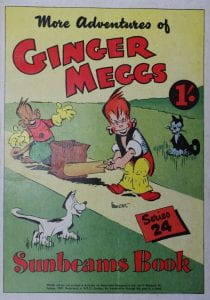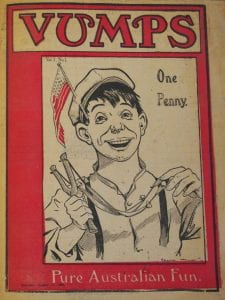Australian Comics: Reflecting on our National Identity through Object-Based Learning
The University of Melbourne’s Special Collections – which comprises Rare Books, Rare Prints and Rare Music Collections – houses approximately 272,000 items, with the Rare Books Collection contributing to 250,000 of those materials. This abundance of primary resources may be utilised for innovative research, especially when considered as an inexhaustible source for Object-Based Learning (or OBL). OBL is a relatively new approach to understanding objects in an academic context, using the kinaesthetic, immersive experience of being in the presence of or handling archival material in order to understand and learn about it more effectively. As an educational methodology, it correlates with the principle concepts of New Materialism theory and its consideration of matter as inherently dynamic and susceptible to taking on new meaning from both human and non-human perspectives.
This abundance of primary resources may be utilised for innovative research, especially when considered as an inexhaustible source for Object-Based Learning (or OBL). OBL is a relatively new approach to understanding objects in an academic context, using the kinaesthetic, immersive experience of being in the presence of or handling archival material in order to understand and learn about it more effectively. As an educational methodology, it correlates with the principle concepts of New Materialism theory and its consideration of matter as inherently dynamic and susceptible to taking on new meaning from both human and non-human perspectives.
When recording, documenting or archiving history, there are always going to be infinite variations of ‘the story of an object’ at play. It’s important that we consistently revisit and reassess how an object has been understood up until this time so as to maintain a critical dialogue surrounding its ontology. This helps us to form a deeper understanding not just of our own personal histories and identities but also of those on a national and international scale.
Within the Rare Books, the comprehensive McLaren Collection contains many early colonial Australian texts including the first official Australian comic magazine, Vumps (1908), Middy Malone’s Magazine (1947) – plus two different issues of Ginger Meggs from the 1920s.
These vibrant, seemingly playful texts soon become a sobering reminder of our fraught colonial history. They provide a gateway for reflection on how conservative Australians still characterise this country according to narratives and ideals that are no longer relevant.
Firstly, there is a display of racism and sexism exhibited in all three of the comics, the grotesque caricatures that feature in Vumps declaring their unequivocal patriotism, the eye-catching colourful strips in Ginger Meggs showing the lead character being physically beaten in nearly all of the sketches and the offensive assumptions about women and people of colour in Middy Malone’s Magazine.
When we physically encounter historical material like this; turn the pages; trace the illustrations with our fingers and hold our breath while handling the fragile pages of a one-hundred-year-old text, we experience a degree of empathy. We realise our place within this larger national historical timeline but also how that history interconnects with our own families and completely unique personal life experiences.
What happens when we ‘re-activate’ these texts and consider them from a current cultural perspective? In the past, whose stories have not been considered important enough to be documented? It is vital that we utilise these materials for research in order to develop a deeper and more enriched understanding of how our national identity has been formed.
Those who come from marginalised groups, who have been hideously misrepresented within these publicly consumed issues, can retell their stories – from their own informed perspective and we can continue to work at dismantling the systemic social and cultural issues that present-day Australia faces.
The comic magazines mentioned above can be viewed in the Reading Room in the Baillieu Library at the University of Melbourne’s Parkville campus. Requests for viewing material must be made online prior to visiting the Reading Room. Please log in or register to do so via Aeon.
Ana Jacobsen
Special Collections and Grainger Museum Blogger
Ana is currently studying a Master of Creative Writing, Editing and Publishing.




Leave a Reply